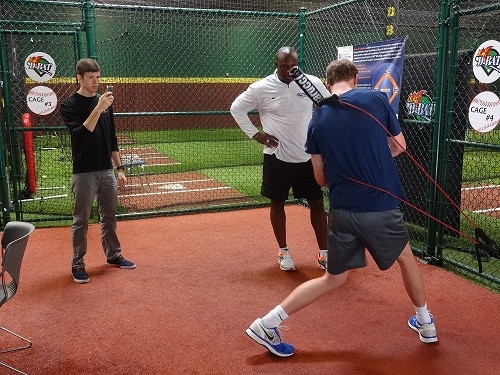In his 2013 Summer internship, SUNY Cortland senior and Dartfish Certified Technologist, Matt Martone teamed up with CJ Stewart, the founder and CEO of Diamond Directors Player Development.

His boss has built a reputation as one of the leading professional hitting instructors in the country. He is a former professional baseball player for the Chicago Cubs and has also served as an area scout for the Cincinnati Reds. As founder and CEO of Diamond Directors Player Development in Atlanta, GA, CJ has over 12 years of player development experience, building an impressive list of clients, including some of the top young prospects in baseball today.
Dartfish questioned Matt on their use of Dartfish and here is what we discovered.
How did you use Dartfish and how did it benefit Diamond Directors?
“At Diamond Directors, Dartfish software primarily provides clients with immediate feedback on their swing. Like most athletic movement, repeating a technique over and over will eventually lead to muscle memory. The goal of integrating Dartfish into hitting lab sessions, is to prevent the repetition of poor mechanics and instead, reinforce proper technique to eventually produce a consistent, successful swing.
“We also overlay videos on top of each other using the Dartfish patented feature, Simulcam. This gives athletes a way to see the progression of their swing from one training session to the next. Over time, the development of a chronological library, housed on dartfish.tv, records their swing progression from their first session to the final product.
“As clients work within the program, they are continually recorded, analyzed, and given immediate feedback using Dartfish and reinforcing well executed technique. Having the ability to review a client’s video after the fact, allows a coach to really focus on the small details, because there is too much to note, within the coaching moment. If CJ saw something he didn’t like, he waited to see if the athlete recognized his mistake. If he didn’t, CJ pointed it out, so they could correct it, before it became permanent. By catching these bad habits early, CJ could prevent them from becoming habitual.”
Which parts of Dartfish technology did you use the most and how often?
“We implemented InTheAction, Mediabooks and a customized Tagging Panel to aid us when working with clients in the hitting lab,” explained Martone. “We also used Simulcam and side-by-side analysis. The InTheAction feature was really fantastic; when working with clients in the hitting cage, CJ could record and play footage throughout the session. He then used this video to give feedback and reinforcement to his clients. The Mediabook feature allowed me to break down the swing into its basic steps for CJ and his clients, and put in notes for CJ to review. Once I got the edited video back to CJ, he had everything he needed to create a training regimen based on the client’s needs. I also worked on integrating the Simulcam feature into CJ’s programs. It gave tremendous benefit to both him and his clients to compare video taken before then after training to see where progress had been made. This also can be used to compare the swings of different clients or to compare practice and game technique. We used Dartfish for every 1-on-1 client session. For each, CJ had the computer and camera set up in the cage. A warmup of hitting some balls off the tee allowed the hitter to focus on the mechanics of the swing without worrying about timing a pitch. After about 20 pitches, he had them watch the video using InTheAction to get their impression of their performance before continuing the hitting lesson with drills or a short distance soft toss. This allowed him to get a sense of their swing, while they focused on the tempo of their movements. Once again, he paused after a few pitches, to review the film together and give feedback.”
How is dartfish.tv used by Diamond Directors?
“On dartfish.tv, CJ keeps a running catalog of each client’s performance, accurately tracking their swing progression. Each client has their own private collection on Diamond Directors’ dartfish.tv channel, serving as an online video reference library for himself and his clients. He can easily view a client’s history and watch, in detail, the progress of the swing, providing understanding of his clients’ needs, so that he can better serve them as a coach.
What did you learn about using hardware?
“Since most of the work is done within the hitting cage, space is an issue. Keeping a compact system is essential to having enough room to move freely. The setup CJ used was a small table, the computer, and a camera mounted on top of the computer. It was very simple to set up and to move when necessary, which provided the opportunity to get a variety of angles if needed, without much effort.
“When filming a swing, the best view was from opposite the batter’s box. From here we could see all the steps of the swing in good detail, providing better analysis. Other views can also be used, if focusing on certain parts of the swing. In front of the batter is great, when observing the athlete’s hands, as they move through the zone. When recording our clients, we liked to get a variety of angles, so we could get an in depth look at the details of their swing. Our primary camera position was perpendicular to the batter, opposite the batter’s box. This vantage point allowed us to get the most useful footage of our clients. From here we could look at key positions like stride length, angle of the bat, the path of the hands through the hitting zone, and the follow through.
“CJ used the Dartfish remote control app for his phone to start and stop recording. This allowed him to easily stop and show video without running back and forth to the computer and wasting session time.”

What insights did you gain interning as a Certified Dartfish Technologist?
“Everything changed for me! I guess that I believed that I could walk in and dazzle CJ with my thorough knowledge of Dartfish and he would immediately use my ideas. However, it was very different. Because he has to focus on so many things at a time, he needs someone who can work independently of him, and at the same time, integrate into his system. I learned to apply my knowledge. My goal became to adapt my skills and use software features to improve the service provided by the coach. I introduced new tools, features, and apps to his program and he was very intrigued with some of these, such as the EasyTag app, the multitude of measuring tools, and Simulcam worked their way into my daily routine, while some he thought just would not fit well with his current regimen. Once I focused on simplifying, I became much more effective as a Dartfish Technologist.
“CJ would occasionally refer to me as his “Coach” for Dartfish. In essence, that was exactly what I was.
“I learned as well that Dartfish brings both motivation and results to CJ’s clients. For some of his younger clients (those in high school and below) being videoed/analyzed is a very unique experience for them. No one else on their team is treated like a pro baseball player, having their every move filmed, critiqued, and analyzed with extreme detail, exactly what CJ does with his MLB clients such as Jason Heyward and Dexter Fowler. What could possibly motivate a young athlete more than being treated and coached like the pros?
“CJ’s clients experience success, both in the cage and on the field, because with each session, the athlete’s skills improve. Their success increases confidence, so they go out on the field and play their best, knowing they have developed the skills to succeed.”
- For more information on Dartfish USA internships contact, Education Director contact Lani Hosley 1.888.655.3850
- Learn more about the work of Diamond Directors and CJ’s charity L.E.A.D that assists disadvantaged young people into education via baseball scholarships
- This article is also available as a PDF document

Comments are closed.